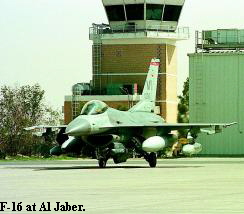|
F-16s use high tech bombs to strike Iraq By Shelby G. Spires
AN AIRBASE IN THE ARABIAN GULF — It's been a long trip for 1st Lt. Jason Koltes. After days of travel he's finally made it to the Gulf for the first patrol rotation
of his career.
Upon arrival at a desert airbase, the 68th Fighter Squadron pilot is positively gleeful even after a seven hour flight from Spain. "I'm glad to be here," the Valdosta fighter pilot said. "I'm ready to
fly the mission to enforce the 'no-fly' zone. If (Saddam Hussein) starts something ... Well, I'm ready to put bombs on target. That's what we're here for."
The ability to bomb day or night, rain or shine, is why
Koltes, along with about 200 members of the 68th Fighter Squadron, have tramped 7,000 miles from South Georgia. The value of the Moody fighter squadrons comes from their ability to utilize precision guided munitions.
The high tech, accurate bombs, otherwise known as PGMs, are used to attack everything from tanks to radars and hardened bunkers. However sophisticated, the bombs are placed on a fighter which was sold as an
unsophisticated, cheap weapons platform.
 Designed 25-years ago, the F-16 was built under the theory of the lightweight fighter. With fewer costly avionics, it was supposed to be about half the cost of the F-15 and therefore
the Pentagon could buy twice as many to counter an impending Soviet threat. Advanced avionics on board the fighter allow it to turn so called "dumb" bombs into smart ones while dive bombing. Designed 25-years ago, the F-16 was built under the theory of the lightweight fighter. With fewer costly avionics, it was supposed to be about half the cost of the F-15 and therefore
the Pentagon could buy twice as many to counter an impending Soviet threat. Advanced avionics on board the fighter allow it to turn so called "dumb" bombs into smart ones while dive bombing.
Generally, the pilots use the Low Altitude Navigation Targeting Infra Red for Night (LANTIRN) pods to pull
targets out of the blur of combat at 600 miles per hour. The dual pods
allow a pilot to fly to a target, site it through an infrared sensor and designate it with a laser. Upon release by the pilot, the bomb will do the rest
Today the F-16 is the backbone of the Air Force's fighter and attack fleet. It's a common presence in the skies over Southwest Asia. Flying 20-30
sorties a day, the pilots who work out of one air base in Kuwait are tasked with a variety of missions. There are those whose job it is to bomb. Others
fly missions specifically designed to keep radars from surface-to-air missile sites shut down. Still a third mission is to attack tanks, armored vehicles and troops.
 The multi purpose F-16 is responsible for all three. The multi purpose F-16 is responsible for all three.
However, it is the PGM duty — the ones which produce the popular cross haired "gun" camera footage from the Gulf War and Bosnia strikes — which the F-16 jockeys pull the most.
"That's our bread and butter," F-16 pilot Col. Mike Nuell said. "The value of the F-16 is its ability to put the PGMs on target and the ability to loft the
HARM missiles and keep the radar sites down ... There's no other fighter like it."
Daily, in Iraq, F-16 are attacking radar and other communications sites in
the north and south "no fly" and "no move" zones of the nation. The F-16 is being given combat tests in an increasingly dangerous slice of airspace.
"I don't think much about that," Koltes said. "It may be dangerous, but that's what I'm hear for. I'm ready to go."
|
|